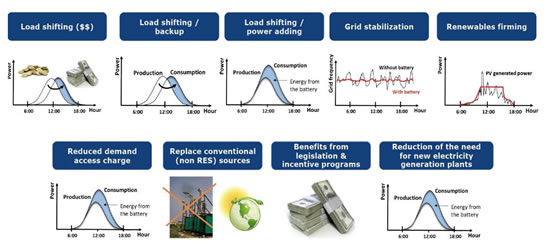EV/HEV market to kickstart battery proliferation
Yole Développement has released a technology & market analysis, entitled Energy Management for Smart Grid, Cities and Building: Opportunities for Battery Electricity Storage Solutions, confirming the impact of EVs/HEVs on the development and deployment of stationary battery electricity storage systems. Tesla's recently-announced battery storage solution, Powerwall, confirms the trends towards massive deployment of distributed stationary storage systems.
“Automated, compact and simple to install, Tesla’s solution, Powerwall offers independence from the utility grid and the security of an emergency backup”, explains Dr Milan Rosina, Senior Analyst, Energy Conversion & Emerging Materials, Yole Développement. “The growing of EV/HEV market is currently reshaping for the stationary battery market.”
This analysis also includes market forecast for stationary battery energy storage systems, an overview of the main players as well as an analysis of the services that could be realised by battery ESS for each analysed segment (renewable energy sources, building, electricity grid).
Rechargeable batteries are particularly suitable for distributed energy storage. Although using a battery as an energy storage solution is decades old, new battery technologies are still maturing and their future cost decrease is expected to significantly speed up the development and deployment of existing and new technologies and applications, thus leading to business opportunities. The growing EV/HEV market is a game changer, driving battery performance improvement and cost decrease. The new Tesla positioning on both EV/HEV and stationary batteries helps it to increase the market volume and to reduce the production costs.

The modular characteristic of battery systems means their size and features can be optimised for differing requirements in a multitude of applications. In particular, their fast demand response capability widens the scope of services (frequency regulation, etc.) that could be provided by batteries, compared to other energy storage technologies. Different battery technologies are commercially available, safe, proven, and used in daily life.
The same battery technology can be used in many different applications (stationary/portable/transport) enabling lower production cost because of higher cumulated production volume, common battery technology development, and simpler logistics. Decreasing battery cost allows broader deployment in both existing and new applications. There is still great potential for further cost reduction and performance enhancement of battery systems.
“As shown in Yole’s report, Energy Management for Smart Grid, Cities & Buildings, the development and cost decrease of lithium-ion batteries, very suitable for applications in transport, will largely be driven by the growing EV/HEV market”, details Dr Rosina. This strong driving force will result in battery technology consolidation associated with decreasing market share for more mature battery technologies such as lead acid and NiMH.
All energy storage technologies currently under development or already being commercially deployed have to face strong competition from Li-ion batteries that have the advantage of high energy density, high power density, high modularity, and decreasing costs.





